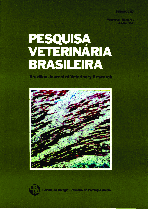 |
|
|
|
Year 2001 - Volume 21, Number 3
|

|
Lentiviruses of small ruminants (CAEV and Maedi-Visna): a review and perspectives, 21(3):87-97
|
ABSTRACT.- Callado A.K.C., Castro R.S. & Teixeira M.F.S. 2001. [Lentiviruses of small ruminants (CAEV and Maedi-Visna): a review and perspectives] Lentivírus de pequenos ruminantes (CAEV e Maedi-Visna): revisão e perspectivas. Pesquisa Veterinária Brasileira 21(3):87-97. Depto Medicina Veterinária, Universidade Federal Rural de Pernambuco, Rua Dom Manoel de Medeiros s/n, Dois Irmãos, Recife, PE 55171-000, Brazil. E-mail: callado@altavista.net
Small ruminant lentiviruses (SRLV), whose prototypes are Caprine Arthritis-Encephalitis virus (CAEV) and Maedi-Visna virus, are the causative agents of slow progressive degenerative diseases of goats and sheep (infected animals), responsible for significant economic losses. These viruses cause persistent infections with long periods of incubation and induce inflammatory and degenerative lesions. The lesions are induced in target organs of the host such as joints, CNS, lungs and mammary glands dueto viral replication in cells of the monocyte/macrophage lineage which is the main target cell. Infections occur particularly in the young and are acquired through ingestion of virus in milk or colostrum from infected does or ewes. The induction of immune response is variable and does not protect against the infection. Diagnosis is primarily based on the presence of SRLV antibodies usually detected by agar gel immunodiffusion (AGID) or enzyme linked immunosorbent assays (ELISA). As no vaccine is available, most often employed schemes to prevent spread of SRLV are based on segregation or/and culling of positive animals associated with management practices, especially the offspring. The strategies of SRLV for dealing with the immune system make difficult to accomplish diagnosis of infection, control or prevention of the viral spread. This review shows aspects of SRLV based on their phylogenetic studies of fields isolates, clinical, and immunopathological features. |
| |
|
|
| |
|
 |